A magnitude 4.7 earthquake that shook parts of New South Wales has damaged homes and businesses, caused power outages and forced some schools to evacuate.
The earthquake struck near Denman in the state’s Upper Hunter region, about 135km from Newcastle, just after 12pm on Friday, according to Geoscience Australia.
It was originally recorded as a magnitude 5, but later downgraded to 4.7.
Know the news with the 7NEWS app: Download today
Senior Seismologist Dr Hadi Ghasemi said the quake was the biggest for the region in the past 20 years.
“In 100 kilometres of the recent event, there are more than 150 events over the past 20 years, this one was of course the largest one, but we also had a magnitude 4.4 in 2019,” Dr Ghasemi said.
Residents reported feeling shakes from Port Macquarie down to Wollongong, with more than 3000 people reporting it with Geoscience Australia.
NSW SES crews are responding to reports about 12 reports of minor infrastructure damage in Maitland and Muswellbrook, but said there was no major impact.


Crib Break Takeaway store in Muswellbrook had to stop trading because the tremors had pulled up parts of the ceiling and left cracks in the building.
Shop owner of 17 years, Terrie-Ann Swan said the two minutes the earthquake lasted was one of the scariest moments of her life.
She’s now nervous about how long it will take to fix the store because they are not insured for loss of trade.
“(We) didn’t actually know what was going on, we didn’t realise it was an earthquake,” Swan said.
“We had a staff member on a break and she was hit by bottles from behind her that were on a storage shelf,” she said.
Other residents took photos of products thrown across shops aisles and bricks shaken from buildings.
Muswellbrook South Public School students were evacuated to the school oval, while St James Primary School told parents the school was without power.
Power provider, Ausgrid, said 2506 customers in Muswellbrook would be without power until Friday evening.
Dr Ghasemi said two further aftershocks of magnitude 3.3 and 2.9 have since been recorded in the Hunter region.
“There is always a possibility that aftershocks will continue in the weeks to come, but as a general rule of thumb, the larger aftershocks tend to occur at the earlier stage of the earthquake,” Ghasemi said.
NSW emergency services called on dam owners to check the integrity of their dams.
He advised people who find themselves in an earthquake to drop to their knees, and take cover under sturdy objects.

